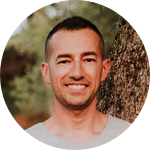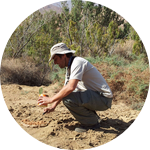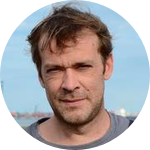About This Project
Egyptian vultures living on the island of Fuerteventura deliberately stain their feather with red soil by taking mud baths. Why these birds apply ‘cosmetics’ remains a mystery. These mud baths may be used as a form of ‘make-up’ to draw attention from other birds, such as during courtship or sexual conflicts, or it may primarily serve a protective function. By focusing on individuality in the use of red muds, my work aims to provide novel insights into the evolution of avian cosmetics.
Ask the Scientists
Join The DiscussionWhat is the context of this research?
Only two species worldwide, the Egyptian vulture and its close relative, the Bearded vulture, are known to paint their feathers with red soil for non-camouflage purposes. Yet, the exact function of this intriguing habit remains unknown, mainly because of the difficulty to observe this behaviour in the wild. Recently, I filmed this behaviour for the first time in the wild (see video), a discovery that reached the worldwide media (new scientist, phys.org, daily mail). The species is endangered worldwide, but 60 breeding pairs and a total population of about 300 individuals still occur on Fuerteventura (Canary Islands, Spain). With most birds being individually marked with plastic rings (>85%), this population offers unique possibilities to unravel the secrets behind this behaviour.
What is the significance of this project?
The Egyptian vulture is a case unique among birds worldwide, with an impressive behavioural repertoire that includes stone throwing to open eggs and feeding on excrement of ungulates which turns their face into yellow. By eating dead animals and thereby avoiding the spread of diseases, many societies have treated them as sacred animals in the past. By studying their unusual and rare habit of mud bathing, this may tell us more about how these birds live and their adaptations, while at the same time, our work aims to discover novel insights into the evolution of avian cosmetics or non-vocal communication in birds in general. Apart from this, by describing the remarkable behaviours of Egyptian vultures, this allows to draw attention to the critical position of this highly threatened bird.
What are the goals of the project?
The main goals of the project are to threefold: I will collect data on social interactions (fights, courtship, preening) and take photographs to quantify natural variation in reddish colouration within and between individuals throughout the year. This will allow to examine individual preferences for red mud and the extent to which red colours are linked to certain behavioural displays. I will provide birds with a choice experiment to examine whether they specifically prefer iron-oxide red muds. Finally, I will provide bowls with red mud in territories located in arid areas and areas with water ponds, to test whether scarcity of this resource influences mud bathing. Our study will be first and most comprehensive examination of this behaviour in the wild.
Budget
Understanding the social behaviour of vultures is key to my research. The budget allows me to make four field trips, to further continue deepening out their social organization and their non-vocal communication skills. The budget covers the basics costs: airplane tickets, car rental and fuel, and bowls to perform experiments. The work is embedded in a larger monitoring protect of this endangered species, headed by Prof. José Donázar from the Estación Biológica Donaña, Sevilla (Spain). However, no funding is available for additional research. As a part-time researcher on this project, I can make use of various facilities such a field station to sleep and hides to perform behavioural observations. I also have legal permission for conducting experiments. I will perform various types of experiments, mostly by providing birds with mud in a bowls at remote locations using camera traps to record their behaviour. A photo camera is available to quantify variation reddish colouration.
Endorsed by
 Project Timeline
Project Timeline
I will collect data during four fieldwork trips, distributed throughout the year and all lasting three weeks. January: mating period. March: egg-laying phase. June: end of the breeding season, important period to test for individual consistency in the use of red muds. September: moulting period, also period of high sociality during which birds gather in large numbers at a social meeting point and at a feeding station After data collection, I will analyse and publish the results.
Oct 19, 2017
Project Launched
Jan 01, 2018
Travel to Fuerteventura
Mar 01, 2018
Travel to Fuerteventura
Jun 01, 2018
Travel to Fuerteventura
Sep 01, 2018
Travel to Fuerteventura
Meet the Team
Team Bio
I will work in close collaboration with Prof. José Donázar, who is head of the vulture group at the Department of Conservation Biology at the Estación Biológica de Doñana, Sevilla (Spain). The main axis of his research focuses on the population ecology of long-lived birds and the trophic ecology of vertebrate communities. Prof. José Donázar is an international leading expert on the biology, evolution, conservation status of vultures.
Mathijs van Overveld
I have a broad interest in evolutionary and behavioural ecology. My research mainly focusses on the causes and consequences of individual variation in behaviour, with special emphasis on individual movement patterns and information gathering strategies. I’m particularly interested in how individuals cope with ecological and social challenging situations, and how such behavioural variation may shape population dynamical processes. Much of this interest has developed during my Ph.D., in which I studied the role of individual variation in behaviour in shaping patterns of dispersal in a small passerine, the great tit (University of Antwerp, Belgium). In the past two years, I was involved in a project on the movement ecology of Egyptian vultures living on the Eastern Canary islands, Spain (based at Estación Biológica Donaña, Sevilla) through a Marie Curie Fellowship from the European Union. In this project, I focussed specifically on individual variation in foraging decisions in relation to supplementary feeding, to quantify the relative ability of individuals to cope with human-induced environmental changes. During this work, I developed a keen interest in the social behaviour and social organization of Egyptian vultures or vultures in general. I also have a special interest in the functional significance of bird colouration. I studied this topic during my Master studies (University of Groningen, The Netherlands), where I have investigated the relationship between throat-feathers (ultraviolet colouration) and reproductive success in starlings, and the fitness consequences of yellow breast coloration in great tits. After my studies I was awarded a grant to participate in a project on intraspecific colour variation in the Crimson Rosella complex (University of Geelong, Australia). Other projects include work on the evolution of parental care in fairy martins (Australia) and Kentish plover (United Arab Emirates).
Lab Notes
Nothing posted yet.
Project Backers
- 9Backers
- 8%Funded
- $334Total Donations
- $37.11Average Donation


